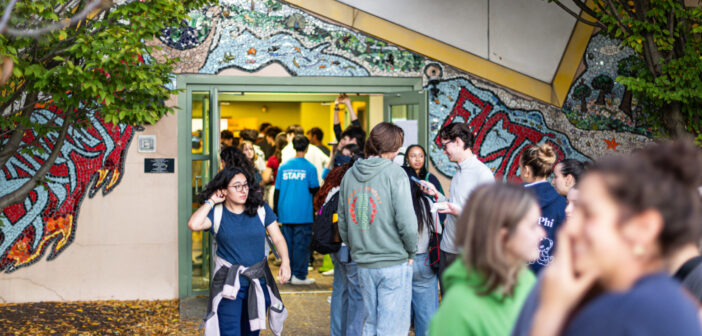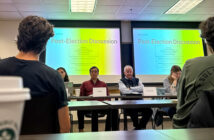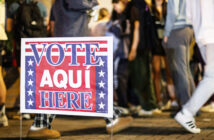On Election Day, Ana Sofia Mendoza, ‘27, left her Trembley Park dorm to head to the Banana Factory to vote, expecting a typical first-time voter experience.
Instead, she waited for six hours and eight minutes to cast her ballot, was interviewed by The New York Times and met celebrity Jonathan Groff.
Mendoza’s experience mirrored that of many Lehigh students who registered to vote using their Mail Center address on Election Day: a 1,038-foot-long voting line turned celebrity hotspot that gained national recognition.
Northampton County has an inventory of 315 machines and typically provides two machines for each of its 154 precincts, according to The Morning Call. This year, the county’s goal was to provide one voting machine for every 450 voters in a precinct.
This target should have equated to four voting machines at the Banana Factory, where 1,853 voters cast their ballots in person on Election Day.
Instead, the day began with three machines, one of which soon broke down. Two additional machines were delivered around noon, followed by two more later.
“The fact that there were only three voting booths at a polling location tailored to an entire university is ridiculous,” said Charlotte Holtby, ‘27, a first-time voter who waited in line at the Banana Factory for over five hours. “They knew that we were coming.”
The issues sparked a lawsuit to extend voting hours by two hours, and the line at the Banana Factory polling location — described by an American Civil Liberties Union representative as “one of the longest lines at any polling place in Pennsylvania” — drew attention and criticism.
The lawsuit was denied, and in the days following the election, Northampton County officials dismissed the inadequate number of voting machines. County officials attributed the long wait times to unexpected voter turnout and logistical delays.
Meanwhile, some students’ frustrations have grown as they continue to question the six-hour wait time and why long wait times persist for on-campus voters.
On Nov. 8, Northampton County Executive Lamont Mcclure told LehighValleyNews.com that officials looked at voter turnout data from 2020 and 2022 before Election Day to allocate resources like voting machines and poll workers to each polling place.
“I’m just not sure our registrar could have contemplated that the turnout would be so much greater than it had been in previous elections,” Mcclure said.
In Bethlehem’s Third Ward — where voters cast ballots at Banana Factory — 45% of registered voters voted in person on Election Day in 2024, up from 29.5% in 2020.
Yet, in 2020, the wait time at the Banana Factory still reached two hours for some voters — exceeding Pennsylvania’s average of 16.6 minutes.
The Brown and White has reported that wait times to vote for on-campus addresses have consistently surpassed two hours for general elections since at least 2008 when they reached three hours.
According to the Presidential Commission on Election Administration, no citizen should have to wait more than 30 minutes to vote.
Brian Fife, the chair of Lehigh’s political science department, said the wait time students experienced was disappointing and shouldn’t have occurred.
“That’s not how to field elections at the local level,” he said before questioning why the county didn’t provide more personnel and machines at the Banana Factory despite ample data indicating higher voter turnout.
All other South Side polling stations opened with two voting machines, and a voting machine also broke at the Cathedral Church of the Nativity.
Additional machines were delivered later in the day to the Cathedral Church of the Nativity and Broughal Middle School, where wait times reached two hours.
Mendoza said she believes 30 minutes is the maximum time someone should have to wait to vote.
According to a report from the American Public Media Research Lab, 72% of Americans agree that under an hour is the acceptable wait time to vote.
The report revealed that long wait times have a different impacts on some groups of voters.
Americans identifying as female, younger, Black or Latino and those with lower education and income levels, were less likely to stay and vote in the 2022 midterm elections if wait times exceeded 90 minutes.
Long lines at polls cost Americans’ voter participation and can impact election outcomes, according to the Bipartisan Policy Center.
The Bipartisan Policy Center found that in 2016, over 560,000 eligible voters didn’t cast a ballot due to polling place management issues, including long lines.
Holtby said she saw people leaving the line at the Banana Factory on Election Day, and she was surprised the polling station wasn’t more organized given Pennsylvania’s status as a key swing state in the 2024 election.
“It just seemed very disorganized, and they seemed very uninterested in our rights to vote,” Holtby said.
David King, ‘25, voted at the Banana Factory in the 2022 midterm election and said he waited two and a half hours. He said while he was waiting in line, the person in front of him collapsed and lost consciousness due to dehydration. King said he had to alert the constable, who didn’t know what to do because there was no food or water available for those in line.
“It definitely wasn’t something they seemed prepared for at all — just like we weren’t prepared to wait that long,” he said.
King said people go to the polls expecting minimal wait times and don’t plan for hour-long delays. He said they often don’t think to bring essentials like food, water, folding chairs or medication to withstand extended lines.
This year at the Banana Factory, an ambulance was called after first-time voter Julia Grumet, ‘28, passed out following a four-hour wait in line.
Grumet has POTS, a congenital heart condition that can cause fainting after prolonged standing. She said she later learned that disability accommodations are available for individuals with conditions like hers, but she found the lack of education about these options as frustrating as the long lines.
“People cannot stay in line for six hours — they have kids, they have work, they have health needs,” King said. “When there’s barriers like long lines to vote, people are forced to choose between voting and fulfilling other crucial responsibilities.”
In addition to Lehigh, colleges across Pennsylvania reported hours-long wait times at their local polling locations. Lines at Lafayette College stretched over three hours, and voters in line at Temple University and Villanova University waited for more than two hours.
In states where voters experience long lines, polling places show disparities. Areas with significant minority populations, high population density and lower income levels tend to face longer wait times.
These areas also tend to vote more Democratic.
In Bethlehem’s Third Ward, 80% of votes cast in the 2024 presidential election were for Vice President Kamala Harris — compared to 48.51% of the total vote in Northampton County.
“It’s more one-sided in our community here, so I almost feel like (the long line) was to deter me away,” Holtby said. “I really felt like I was being set up to leave.”
She said she felt the system was distancing Lehigh students from voting, as they tend to vote more blue than Bethlehem’s surrounding population.
Grumet said the line she encountered was “a lack of oversight so significant, (she) didn’t believe it was 100% on accident” and said the suppression she experienced fueled her resolve to vote.
After she regained consciousness on Election Day, she insisted on voting and was wheeled into the booth in a wheelchair.
“It shows that our generation is committed to elections and the future state of our country, but it isn’t something that should be celebrated,” Mendoza said. “If anything, it should serve as a lesson.”
King, Mendoza, Grumet and Holtby all said they hope the county will take accountability and implement reforms moving forward. This could include increased numbers of voting machines or reevaluations of how voters are assigned to polling locations.
Guidelines from the Presidential Commission on Election Administration emphasize that voting lines can be minimized by accurately estimating voter turnout and ensuring polling locations are staffed with well-trained workers, including those who can assist disabled and non-English-speaking voters.
“All across the country, local officials do this because they want to earnestly ensure that people who take the time to vote are not impositioned to any great extent,” Fife said.
He said he hopes and expects officials in Northampton County will stop repeating past mistakes and take action to ensure people aren’t waiting six hours to vote again.
Grumet said she will either make use of disability accommodations or vote by mail in the future.
“I probably will be early voting for the rest of my life,” Holtby said. “And I’ll talk about this election probably also for the rest of my life, about how crazy it was and why I don’t vote in person anymore.”






Comment policy
Comments posted to The Brown and White website are reviewed by a moderator before being approved. Incendiary speech or harassing language, including comments targeted at individuals, may be deemed unacceptable and not published. Spam and other soliciting will also be declined.
The Brown and White also reserves the right to not publish entirely anonymous comments.